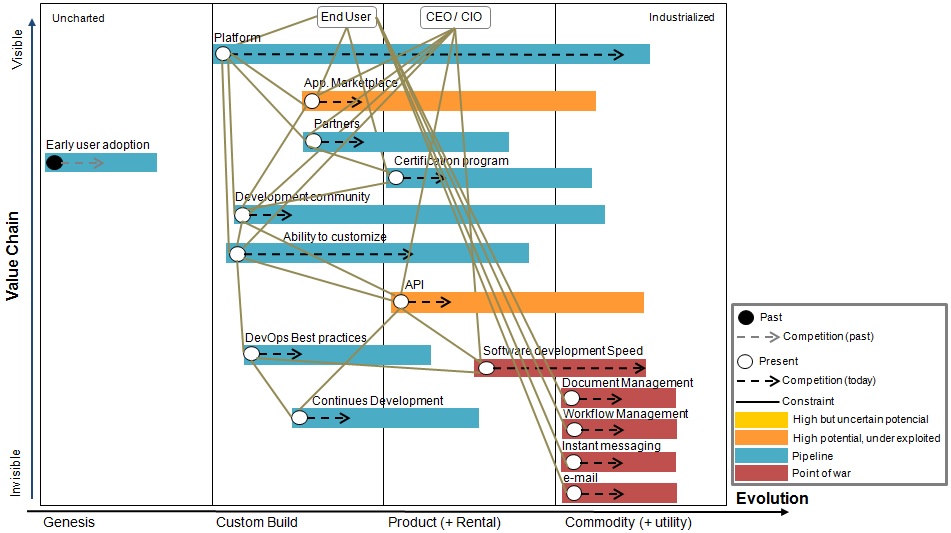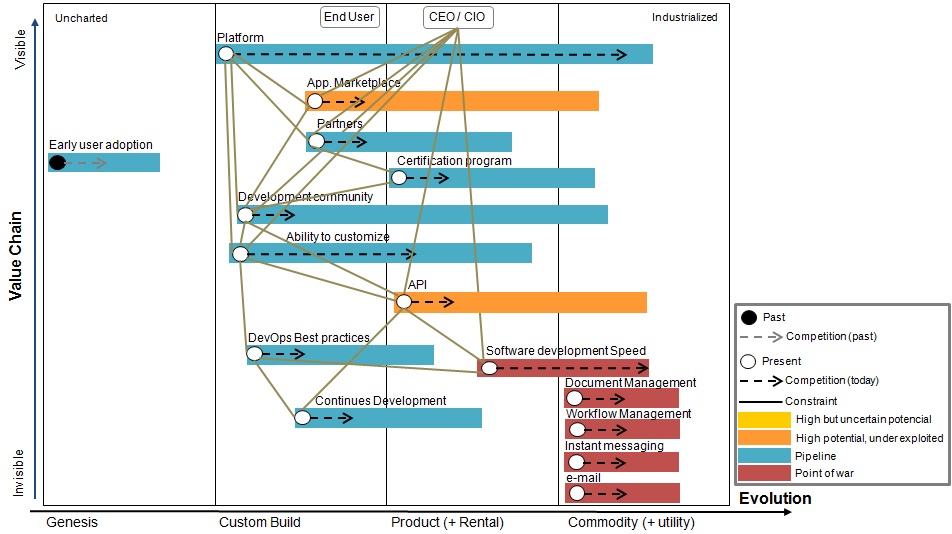So many companies are moving from their current environments to the new ecosystems available in the market. This drives the organizations to perform a rationalization of their portfolios.
This is no-brainer, but the first step is to understand your current portfolio of assets and what are your business priorities for the future. Once done, next step is the selection of the target ecosystems. There are different ecosystems in the market available, and the first questions to be asked are:
- What are the best ones for my organization needs?
- Do they integrate properly with respect my needs?
- How mature is my organization to embrace the selected ecosystem?
Below I have tried to define what are the components of the different ecosystems or platforms, independently of the business processes or the industry where the organization is:
 The picture is full of lines, so let’s divide them from end-user and CEO/CIO point of view. I have added CEO on purpose, because the IT activities are not a support department anymore. Some organizations still do not understand that IT is a core capability of their organization and this is a big mistake.
The picture is full of lines, so let’s divide them from end-user and CEO/CIO point of view. I have added CEO on purpose, because the IT activities are not a support department anymore. Some organizations still do not understand that IT is a core capability of their organization and this is a big mistake.
For the end-user:
- Platform, is the environment where they access and perform their duties. User experience is key and a logical way to integrate with different tools and services is relevant to enable the expert users to dig into the platform and obtain as much benefits of its use. The user assumes they can send e-mails, manage documentation, chat with their colleagues, perform workflow activities…. This is not an added value, it’s a must.
- Applications marketplace: users are wise people with specific needs. The platform does not need to satisfy all specific needs, but an application marketplace that offers specific solutions is important to make your platform to fit within your business needs.
- Certification program: it enables the organization to have a clear roadmap of required knowledge your teams require. It also sets some standards on the use of the platform. Finally these programs also enable the business to understand the technical side of the platform which is key when managing transformation projects.
- Development community: the link with the end users is the applications marketplace, but in addition this can be also linked with specific projects done by a third party. The third parties have to be able to provide customized solutions, respecting the platform best practices and enabling a long term use of these specific solutions. Here the robustness of the platform is key.
For the CIO / CEO. The majority of the comments are around the value of time, as this is the key aspect we have to look at long term: time to market.
- Application marketplace, relevant to access to specific solutions for your organization. You pay, but immediately you obtain the solution on your environment. You will enable the different business units to invest their money where they want.
- Partners network is important to understand if we can integrate the other assets we have on the target ecosystem. We require flexibility to enable the platform to adapt to our organization. A platform without integration with the main vendors will drive us to an isolated environment with limits at medium term, which will finalize with a fiasco and more $$ investment.
- Development community. We have to understand how big is the development community, understand if there are qualified vendors with these capabilities, if we can create a competitive environment, if we just can depend on a given partner…
- API, indeed the versatility of the API for your partners, your third parties, the development community.
- Continuous development: this is key when the complexity of your platform is increased and you are attending needs from different BUs into the same environment. How fast, which quality and how stable is the delivery of new pieces of software is a relevant aspect.
- Software development speed. This indirect parameter is the more relevant aspect of the map, because it gives you a lot of information about the rest of the components and how they impact on your time to market.
The origin of a slow software development speed could be:
- The platform does not have a good API to integrate other systems.
- The first integrations are easy but continues development of different activities makes the integrations more complex and the platform is not able to respond quickly.
- There are too much re-coding.
- There are not good quality checks of the code.
- There is not a good development community.
- There are not good partnerships with other vendors that require to perform extra efforts for integration.
- Once the complexity of the environment is increased the time to market decreases. Stress analysis and understand the limits of the environment is key.
- The distance between the business requirements and technical solution is so far away and it makes the achievement of the new solutions to be a complex process.
- You have not knowledge of the platform in house to launch/manage these type of projects.
Fast software development speed means:
- You will reach the market faster,
- You attend your business processes faster,
- You can define shorter cycles of software delivery.
- You potentially will be more competitive.
In 1961 organizations tried to send a man on the moon. In 2015 organizations try to be the fastest developing code.
Ok joapen, but you did not answer “which ecosystem/s are the right ones for me?”
No I did not, this is just an introduction of the main aspects of this exercise. To be continued.

